Anechoic Room on:
[Wikipedia]
[Google]
[Amazon]
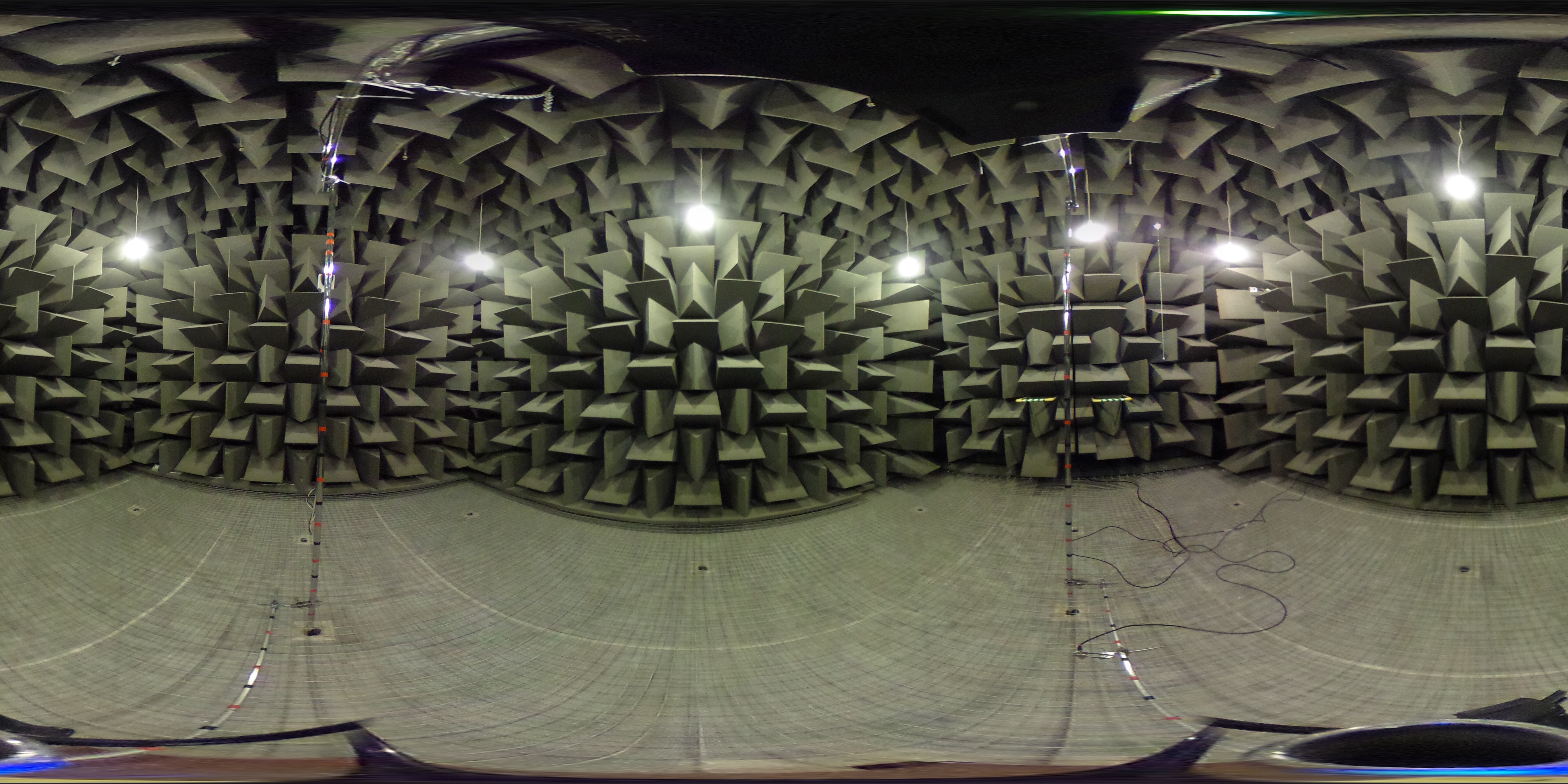
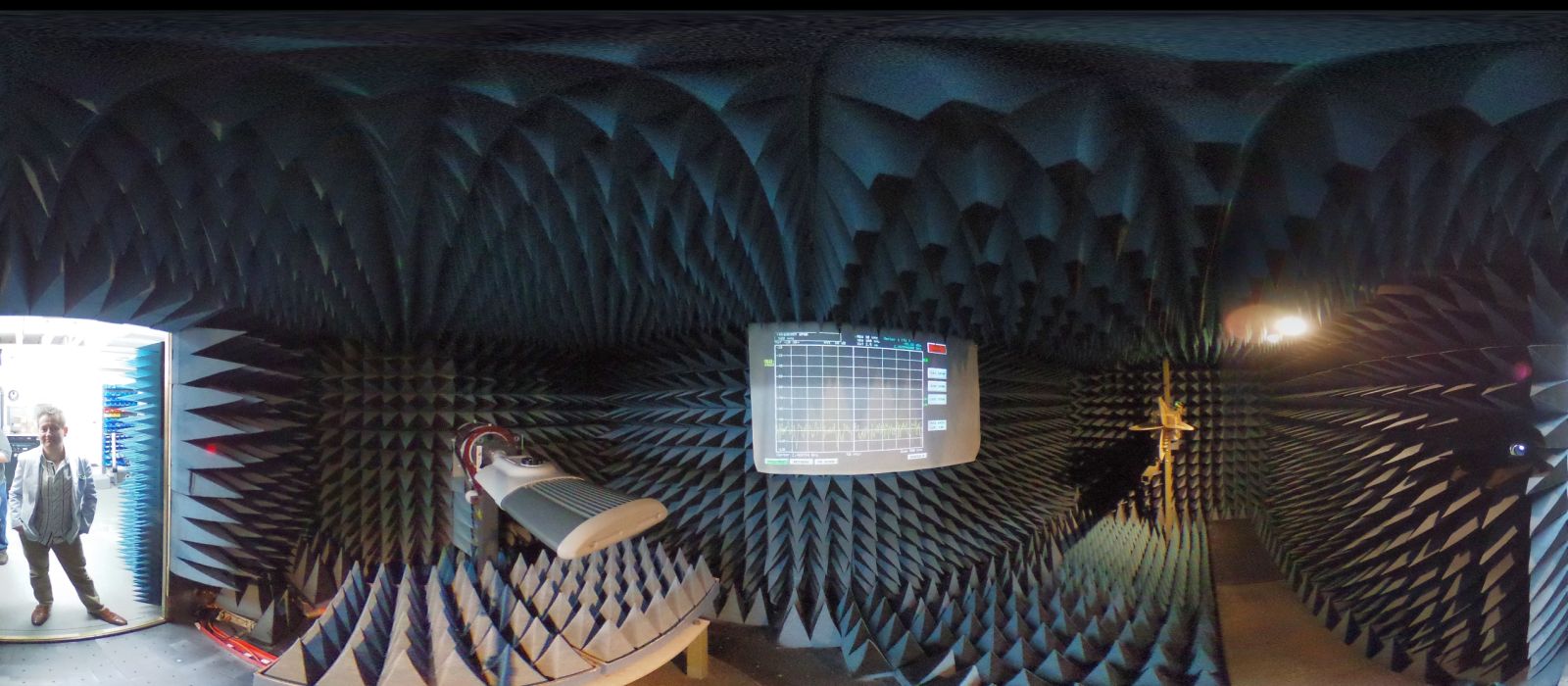 An anechoic chamber (''an-echoic'' meaning "non-reflective") is a room designed to stop reflections of either sound or
An anechoic chamber (''an-echoic'' meaning "non-reflective") is a room designed to stop reflections of either sound or
 The requirement for what was subsequently called an anechoic chamber originated to allow testing of loudspeakers that generated such intense sound levels that they could not be tested outdoors in inhabited areas.
Anechoic chambers are commonly used in acoustics to conduct experiments in nominally " free field" conditions, free field meaning that there are no reflected signals. All sound energy will be traveling away from the source with almost none reflected back. Common anechoic chamber experiments include measuring the transfer function of a loudspeaker or the
The requirement for what was subsequently called an anechoic chamber originated to allow testing of loudspeakers that generated such intense sound levels that they could not be tested outdoors in inhabited areas.
Anechoic chambers are commonly used in acoustics to conduct experiments in nominally " free field" conditions, free field meaning that there are no reflected signals. All sound energy will be traveling away from the source with almost none reflected back. Common anechoic chamber experiments include measuring the transfer function of a loudspeaker or the
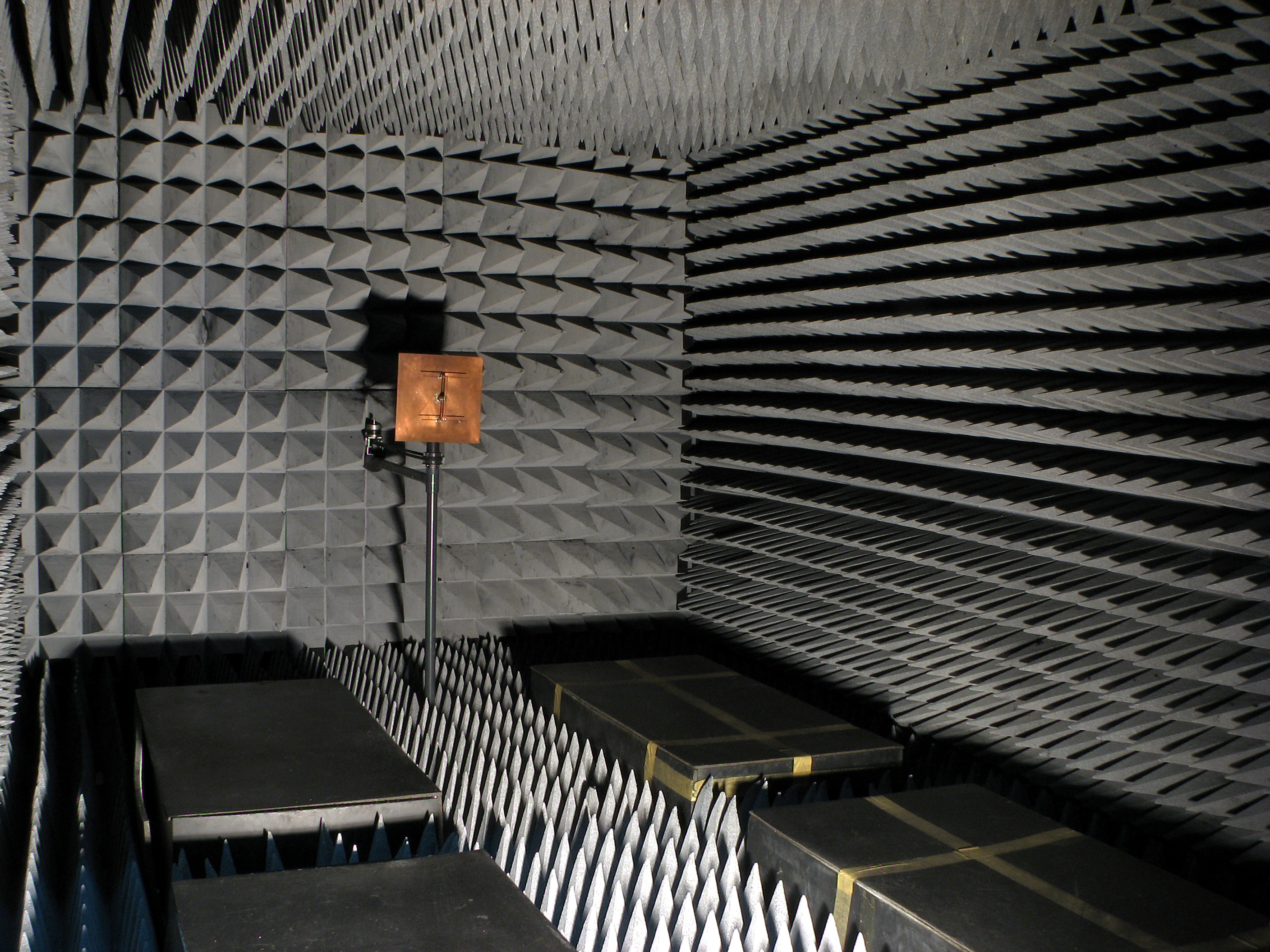
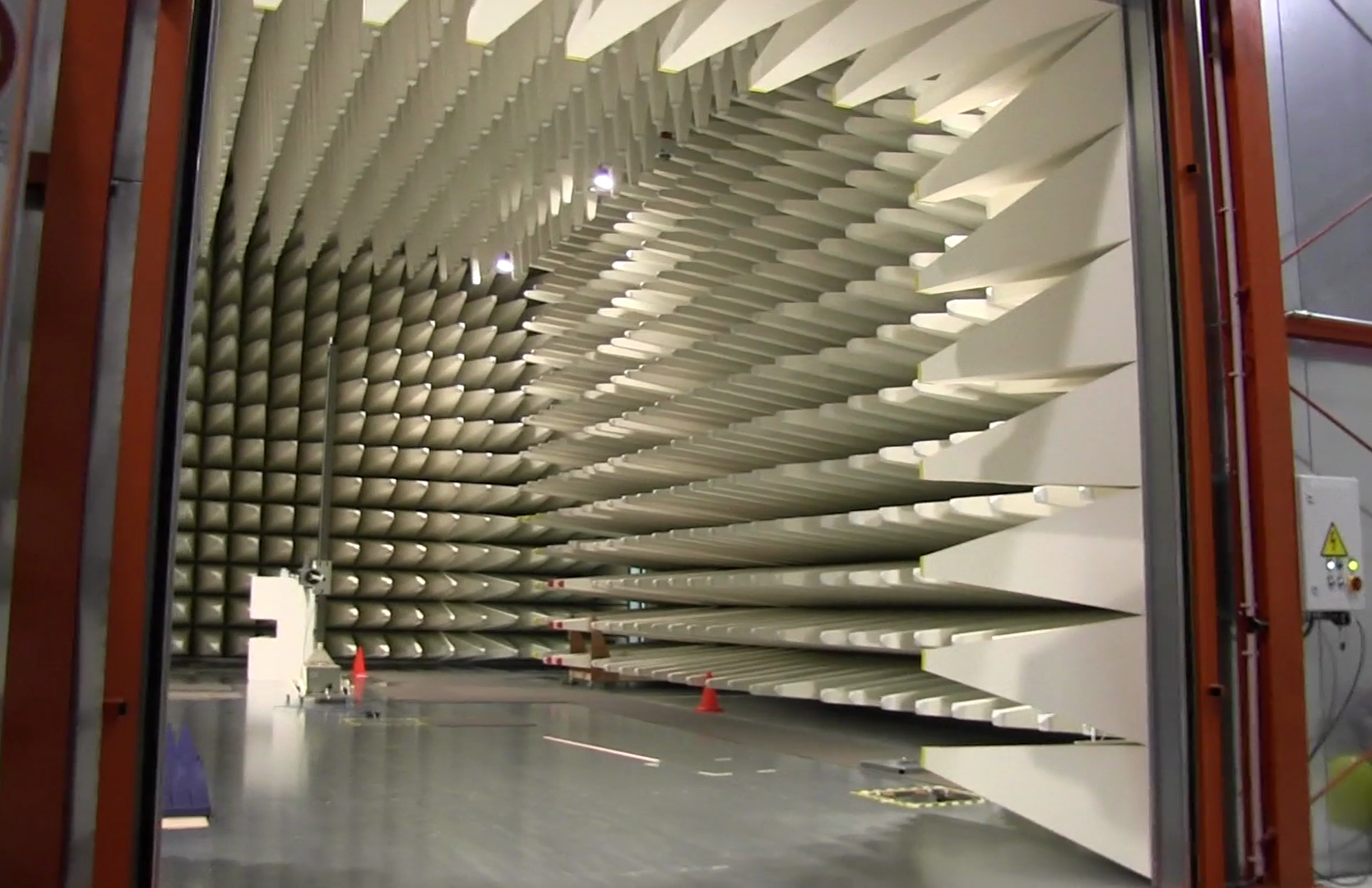
 The internal appearance of the radio frequency (RF) anechoic chamber is sometimes similar to that of an acoustic anechoic chamber; however, the interior surfaces of the RF anechoic chamber are covered with radiation absorbent material (RAM) instead of acoustically absorbent material. Uses for RF anechoic chambers include testing antennas, radars, and is typically used to house the antennas for performing measurements of
The internal appearance of the radio frequency (RF) anechoic chamber is sometimes similar to that of an acoustic anechoic chamber; however, the interior surfaces of the RF anechoic chamber are covered with radiation absorbent material (RAM) instead of acoustically absorbent material. Uses for RF anechoic chambers include testing antennas, radars, and is typically used to house the antennas for performing measurements of
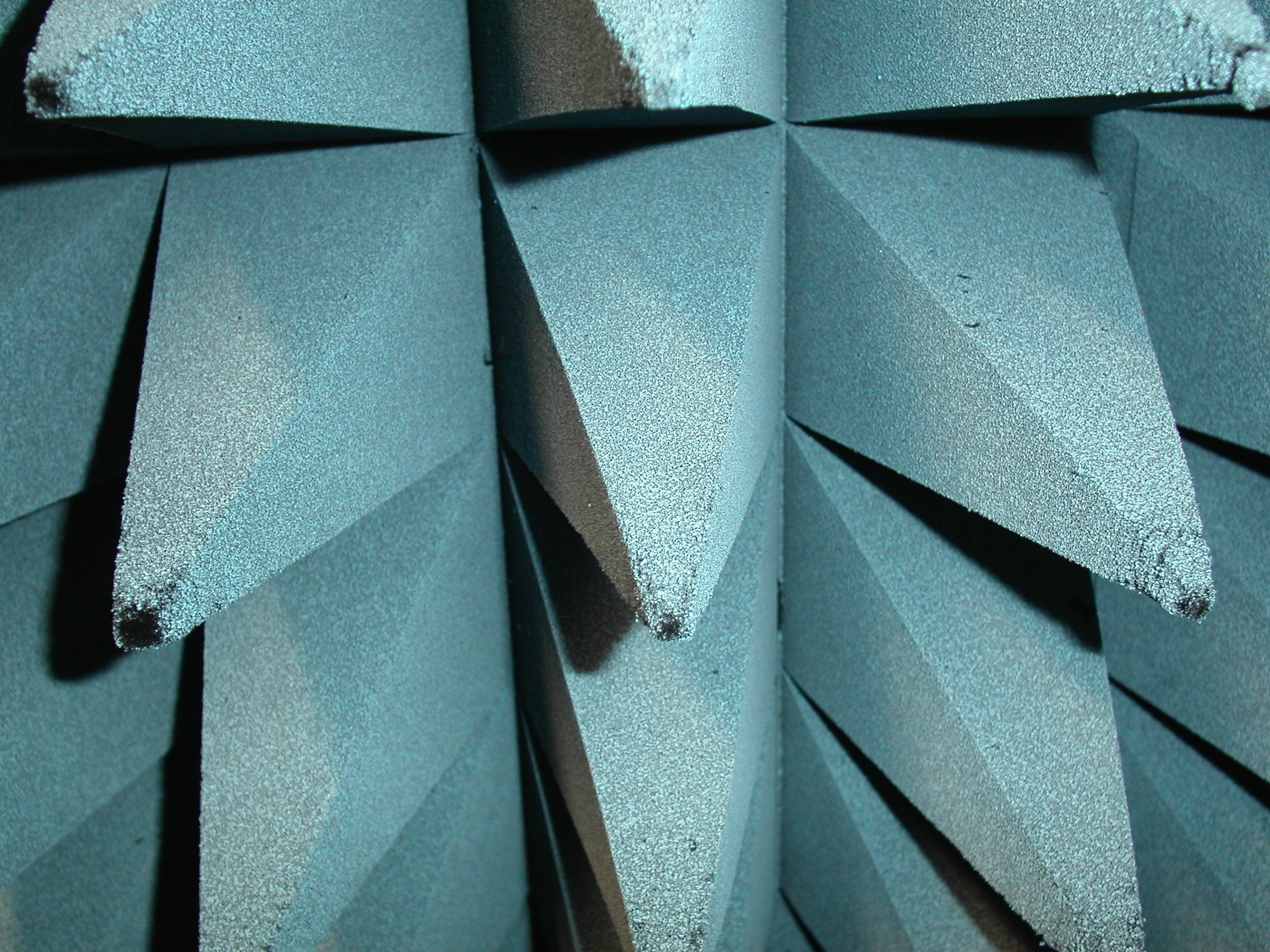 Waves of higher frequencies have shorter wavelengths and are higher in energy, while waves of lower frequencies have longer wavelengths and are lower in energy, according to the relationship where lambda represents wavelength, v is phase velocity of wave, and is frequency. To shield for a specific wavelength, the cone must be of appropriate size to absorb that wavelength. The performance quality of an RF anechoic chamber is determined by its lowest test frequency of operation, at which measured reflections from the internal surfaces will be the most significant compared to higher frequencies. Pyramidal RAM is at its most absorptive when the incident wave is at normal incidence to the internal chamber surface and the pyramid height is approximately equal to , where is the free space wavelength. Accordingly, increasing the pyramid height of the RAM for the same ( square) base size improves the effectiveness of the chamber at low frequencies but results in increased cost and a reduced unobstructed working volume that is available inside a chamber of defined size.
Waves of higher frequencies have shorter wavelengths and are higher in energy, while waves of lower frequencies have longer wavelengths and are lower in energy, according to the relationship where lambda represents wavelength, v is phase velocity of wave, and is frequency. To shield for a specific wavelength, the cone must be of appropriate size to absorb that wavelength. The performance quality of an RF anechoic chamber is determined by its lowest test frequency of operation, at which measured reflections from the internal surfaces will be the most significant compared to higher frequencies. Pyramidal RAM is at its most absorptive when the incident wave is at normal incidence to the internal chamber surface and the pyramid height is approximately equal to , where is the free space wavelength. Accordingly, increasing the pyramid height of the RAM for the same ( square) base size improves the effectiveness of the chamber at low frequencies but results in increased cost and a reduced unobstructed working volume that is available inside a chamber of defined size.
360-degree video of an anechoic chamber
Pictures and description of an acoustic anechoic chamber
Anechoic Chambers, Past and Present
How RF Anechoic Chambers Work
Video tour of an EMC/RF Test facility. Including the largest anechoic test chamber in the southern hemisphere
* Some examples *
*
Millimeter Wave Inc's Radio/MM Wave anechoic chamber
*
*
Anechoic chamber for millimeter wave designs
** *
** ttps://web.archive.org/web/20071107061848/http://acs.feld.cvut.cz/old/komora.html Photos from building an anechoic chamber in CTU, Prague*Sound examples *
The sound of clothes inside an anechoic chamber
*
Hallucinations in anechoic chambers: the science behind the claim
*
Listen to a subdued balloon burst in an anechoic chamber
{{DEFAULTSORT:Anechoic Chamber Laboratories Electromagnetic radiation Silence Radiation Rooms Noise control Acoustics

 An anechoic chamber (''an-echoic'' meaning "non-reflective") is a room designed to stop reflections of either sound or
An anechoic chamber (''an-echoic'' meaning "non-reflective") is a room designed to stop reflections of either sound or electromagnetic waves
In physics, electromagnetic radiation (EMR) consists of waves of the electromagnetic (EM) field, which propagate through space and carry momentum and electromagnetic radiant energy. It includes radio waves, microwaves, infrared, (visible) lig ...
. They are also often isolated from energy entering from their surroundings. This combination means that a person or detector exclusively hears direct sounds (no reflected Reflection or reflexion may refer to:
Science and technology
* Reflection (physics), a common wave phenomenon
** Specular reflection, reflection from a smooth surface
*** Mirror image, a reflection in a mirror or in water
** Signal reflection, in ...
sounds), in effect simulating being outside in a free field.
Anechoic chambers, a term coined by American acoustics expert Leo Beranek, were initially exclusively used to refer to acoustic anechoic chambers. Recently, the term has been extended to other RF and Sonar anechoic chambers, which eliminate reflection and external noise caused by electromagnetic waves.
Anechoic chambers range from small compartments the size of household microwave ovens to ones as large as aircraft hangars. The size of the chamber depends on the size of the objects and frequency ranges being tested.
Acoustic anechoic chambers
 The requirement for what was subsequently called an anechoic chamber originated to allow testing of loudspeakers that generated such intense sound levels that they could not be tested outdoors in inhabited areas.
Anechoic chambers are commonly used in acoustics to conduct experiments in nominally " free field" conditions, free field meaning that there are no reflected signals. All sound energy will be traveling away from the source with almost none reflected back. Common anechoic chamber experiments include measuring the transfer function of a loudspeaker or the
The requirement for what was subsequently called an anechoic chamber originated to allow testing of loudspeakers that generated such intense sound levels that they could not be tested outdoors in inhabited areas.
Anechoic chambers are commonly used in acoustics to conduct experiments in nominally " free field" conditions, free field meaning that there are no reflected signals. All sound energy will be traveling away from the source with almost none reflected back. Common anechoic chamber experiments include measuring the transfer function of a loudspeaker or the directivity
In electromagnetics, directivity is a parameter of an antenna or optical system which measures the degree to which the radiation emitted is concentrated in a single direction. It is the ratio of the radiation intensity in a given direction from ...
of noise radiation from industrial machinery. In general, the interior of an anechoic chamber can be very quiet, with typical noise levels in the 10–20 dBA range. In 2005, the best anechoic chamber measured at −9.4 dBA. In 2015, an anechoic chamber on the campus of Microsoft broke the world record with a measurement of −20.6 dBA. The human ear can typically detect sounds above 0 dBA, so a human in such a chamber would perceive the surroundings as devoid of sound. Anecdotally, some people may not like such silence and can become disoriented.
The mechanism by which anechoic chambers minimize the reflection of sound waves impinging onto their walls is as follows: In the included figure, an incident sound wave I is about to impinge onto a wall of an anechoic chamber. This wall is composed of a series of wedges W with height H. After the impingement, the incident wave I is reflected as a series of waves R which in turn "bounce up-and-down" in the gap of air A (bounded by dotted lines) between the wedges W. Such bouncing may produce (at least temporarily) a standing wave pattern in A. During this process, the acoustic energy of the waves R gets dissipated via the air's molecular viscosity, in particular near the corner C. In addition, with the use of foam materials to fabricate the wedges, another dissipation mechanism happens during the wave/wall interactions. As a result, the component of the reflected waves R along the direction of I that escapes the gaps A (and goes back to the source of sound), denoted R', is notably reduced. Even though this explanation is two-dimensional, it is representative and applicable to the actual three-dimensional wedge structures used in anechoic chambers.
Semi-anechoic and hemi-anechoic chambers
Full anechoic chambers aim to absorb energy in all directions. To do this, all surfaces, including the floor, need to be covered in correctly shaped wedges. A mesh grille is usually installed above the floor to provide a surface to walk on and place equipment. This mesh floor is typically placed at the same floor level as the rest of the building, meaning the chamber itself extends ''below'' floor level. This mesh floor is damped and floating on absorbent buffers to isolate it from outside vibration or electromagnetic signals. In contrast, semi-anechoic or hemi-anechoic chambers have a solid floor that acts as a work surface for supporting heavy items, such as cars, washing machines, or industrial machinery, which could not be supported by the mesh grille in a full anechoic chamber.Recording studio
A recording studio is a specialized facility for sound recording, mixing, and audio production of instrumental or vocal musical performances, spoken words, and other sounds. They range in size from a small in-home project studio large enoug ...
s are often semi-anechoic.
The distinction between "semi-anechoic" and "hemi-anechoic" is unclear. In some uses they are synonyms, or only one term is used. Other uses distinguish one as having an ideally reflective floor (creating free-field conditions with a single reflective surface) and the other as simply having a flat untreated floor. Still other uses distinguish them by size and performance, with one being likely an existing room retrofitted with acoustic treatment, and the other a purpose-built room which is likely larger and has better anechoic performance.
Radio-frequency anechoic chambers


 The internal appearance of the radio frequency (RF) anechoic chamber is sometimes similar to that of an acoustic anechoic chamber; however, the interior surfaces of the RF anechoic chamber are covered with radiation absorbent material (RAM) instead of acoustically absorbent material. Uses for RF anechoic chambers include testing antennas, radars, and is typically used to house the antennas for performing measurements of
The internal appearance of the radio frequency (RF) anechoic chamber is sometimes similar to that of an acoustic anechoic chamber; however, the interior surfaces of the RF anechoic chamber are covered with radiation absorbent material (RAM) instead of acoustically absorbent material. Uses for RF anechoic chambers include testing antennas, radars, and is typically used to house the antennas for performing measurements of antenna
Antenna ( antennas or antennae) may refer to:
Science and engineering
* Antenna (radio), also known as an aerial, a transducer designed to transmit or receive electromagnetic (e.g., TV or radio) waves
* Antennae Galaxies, the name of two collid ...
radiation patterns, electromagnetic interference
Electromagnetic interference (EMI), also called radio-frequency interference (RFI) when in the radio frequency spectrum, is a disturbance generated by an external source that affects an electrical circuit by electromagnetic induction, electros ...
.
Performance expectations (gain, efficiency, pattern characteristics, etc.) constitute primary challenges in designing stand alone or embedded antennas. Designs are becoming ever more complex with a single device incorporating multiple technologies such as cellular, WiFi, Bluetooth, LTE
LTE may refer to:
Science and technology
* LTE (telecommunication) (Long-Term Evolution), a telephone and mobile broadband standard
** LTE Advanced, an enhancement
*** LTE Advanced Pro
* Compaq LTE, a line of laptop computers produced by Compaq
* ...
, MIMO, RFID
Radio-frequency identification (RFID) uses electromagnetic fields to automatically identify and track tags attached to objects. An RFID system consists of a tiny radio transponder, a radio receiver and transmitter. When triggered by an electromag ...
and GPS
The Global Positioning System (GPS), originally Navstar GPS, is a Radionavigation-satellite service, satellite-based radionavigation system owned by the United States government and operated by the United States Space Force. It is one of t ...
.
Radiation-absorbent material
RAM is designed and shaped to absorb incident RF radiation (also known as non-ionising radiation) as effectively as possible, from as many incident directions as possible. The more effective the RAM, the lower the resulting level ofreflected Reflection or reflexion may refer to:
Science and technology
* Reflection (physics), a common wave phenomenon
** Specular reflection, reflection from a smooth surface
*** Mirror image, a reflection in a mirror or in water
** Signal reflection, in ...
RF radiation. Many measurements in electromagnetic compatibility
Electromagnetic compatibility (EMC) is the ability of electrical equipment and systems to function acceptably in their electromagnetic environment, by limiting the unintentional generation, propagation and reception of electromagnetic energy whic ...
(EMC) and antenna radiation patterns require that spurious signals arising from the test setup, including reflections, are negligible to avoid the risk of causing measurement errors
Observational error (or measurement error) is the difference between a measured value of a quantity and its true value.Dodge, Y. (2003) ''The Oxford Dictionary of Statistical Terms'', OUP. In statistics, an error is not necessarily a "mistake". ...
and ambiguities.
Effectiveness over frequency
Installation into a screened room
An RF anechoic chamber is usually built into a screened room, designed using theFaraday cage
A Faraday cage or Faraday shield is an enclosure used to block electromagnetic fields. A Faraday shield may be formed by a continuous covering of conductive material, or in the case of a Faraday cage, by a mesh of such materials. Faraday cage ...
principle. This is because most of the RF tests that require an anechoic chamber to minimize reflections from the inner surfaces also require the properties of a screened room to attenuate unwanted signals penetrating inwards and causing interference to the equipment under test and prevent leakage from tests penetrating outside.
Chamber size and commissioning
At lower radiated frequencies, far-field measurement can require a large and expensive chamber. Sometimes, for example for radar cross-section measurements, it is possible to scale down the object under test and reduce the chamber size, provided that the wavelength of the test frequency is scaled down in direct proportion by testing at a higher frequency. RF anechoic chambers are normally designed to meet the electrical requirements of one or more accredited standards. For example, the aircraft industry may test equipment for aircraft according to company specifications or military specifications such as MIL-STD 461E. Once built, acceptance tests are performed during commissioning to verify that the standard(s) are in fact met. Provided they are, a certificate will be issued to that effect. The chamber will need to be periodically retested.Operational use
Test and supporting equipment configurations to be used within anechoic chambers must expose as few metallic (conductive) surfaces as possible, as these risk causing unwanted reflections. Often this is achieved by using non-conductive plastic or wooden structures for supporting the equipment under test. Where metallic surfaces are unavoidable, they may be covered with pieces of RAM after setting up to minimize such reflection as far as possible. A careful assessment may be required as to whether the test equipment (as opposed to the equipment under test) should be placed inside or outside the chamber. Typically most of it is located in a separate screened room attached to the main test chamber, in order to shield it from both external interference and from the radiation within the chamber. Mains power and test signal cabling into the test chamber require high qualityfiltering
Filter, filtering or filters may refer to:
Science and technology
Computing
* Filter (higher-order function), in functional programming
* Filter (software), a computer program to process a data stream
* Filter (video), a software component tha ...
.
Fiber optic cables are sometimes used for the signal cabling, as they are immune to ordinary RFI and also cause little reflection inside the chamber.
Health and safety risks associated with RF anechoic chamber
The following health and safety risks are associated with RF anechoic chambers: *RF radiation hazard *Fire hazard *Trapped personnel Personnel are not normally permitted inside the chamber during a measurement as this not only can cause unwanted reflections from thehuman body
The human body is the structure of a Human, human being. It is composed of many different types of Cell (biology), cells that together create Tissue (biology), tissues and subsequently organ systems. They ensure homeostasis and the life, viabi ...
but may also be a radiation hazard to the personnel concerned if tests are being performed at high RF powers. Such risks are from RF or non-ionizing radiation and not from the higher energy ionizing radiation
Ionizing radiation (or ionising radiation), including nuclear radiation, consists of subatomic particles or electromagnetic waves that have sufficient energy to ionize atoms or molecules by detaching electrons from them. Some particles can travel ...
.
As RAM is highly absorptive of RF radiation, incident radiation will generate heat within the RAM. If this cannot be dissipated adequately there is a risk that hot spots may develop and the RAM temperature may rise to the point of combustion. This can be a risk if a transmitting antenna inadvertently gets too close to the RAM. Even for quite modest transmitting power levels, high gain
Gain or GAIN may refer to:
Science and technology
* Gain (electronics), an electronics and signal processing term
* Antenna gain
* Gain (laser), the amplification involved in laser emission
* Gain (projection screens)
* Information gain in de ...
antennas can concentrate the power sufficiently to cause high power flux
Flux describes any effect that appears to pass or travel (whether it actually moves or not) through a surface or substance. Flux is a concept in applied mathematics and vector calculus which has many applications to physics. For transport ph ...
near their apertures. Although recently manufactured RAM is normally treated with a fire retardant to reduce such risks, they are difficult to eliminate. Safety regulations normally require the installation of a gaseous fire suppression system including smoke detectors.
See also
* Soundproofing * Vibration isolation * Buffer (disambiguation) * Damped wave *Damping ratio
Damping is an influence within or upon an oscillatory system that has the effect of reducing or preventing its oscillation. In physical systems, damping is produced by processes that dissipate the energy stored in the oscillation. Examples inc ...
* Damper (disambiguation)
* Electromagnetic reverberation chamber
* Reverberation room
* Sensory deprivation
Sensory deprivation or perceptual isolation is the deliberate reduction or removal of stimuli from one or more of the senses. Simple devices such as blindfolds or hoods and earmuffs can cut off sight and hearing, while more complex devices can al ...
* GTEM cell
A TEM or transverse electromagnetic cell is a type of test chamber used to perform electromagnetic compatibility (EMC) or electromagnetic interference (EMI) testing. It allows for the creation of Near and far field, far field electromagnetic fields ...
References
External links
360-degree video of an anechoic chamber
Pictures and description of an acoustic anechoic chamber
Anechoic Chambers, Past and Present
How RF Anechoic Chambers Work
Video tour of an EMC/RF Test facility. Including the largest anechoic test chamber in the southern hemisphere
* Some examples *
*
Millimeter Wave Inc's Radio/MM Wave anechoic chamber
*
*
Anechoic chamber for millimeter wave designs
** *
** ttps://web.archive.org/web/20071107061848/http://acs.feld.cvut.cz/old/komora.html Photos from building an anechoic chamber in CTU, Prague*Sound examples *
The sound of clothes inside an anechoic chamber
*
Hallucinations in anechoic chambers: the science behind the claim
*
Listen to a subdued balloon burst in an anechoic chamber
{{DEFAULTSORT:Anechoic Chamber Laboratories Electromagnetic radiation Silence Radiation Rooms Noise control Acoustics